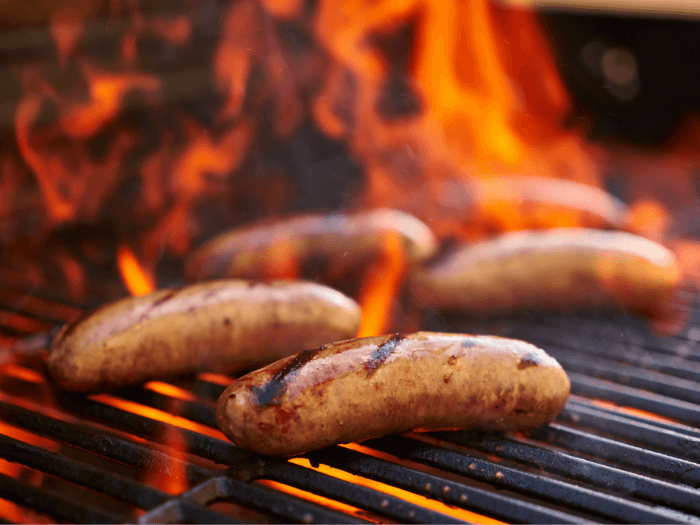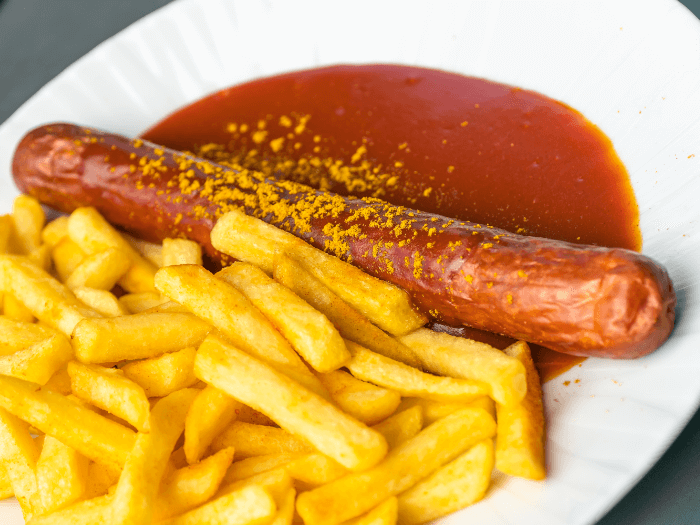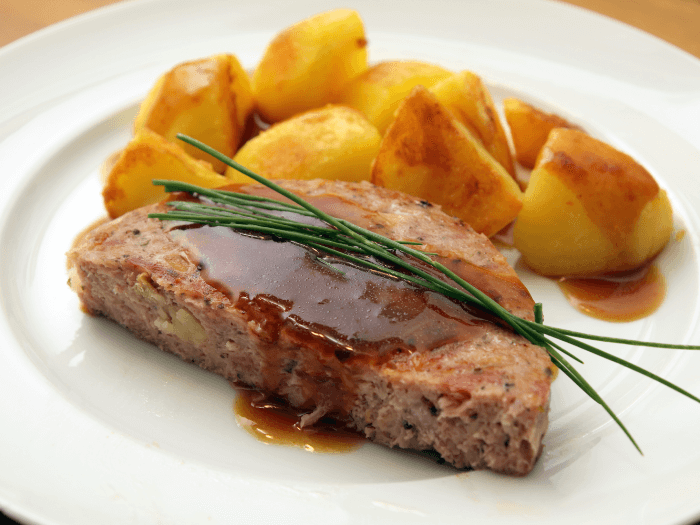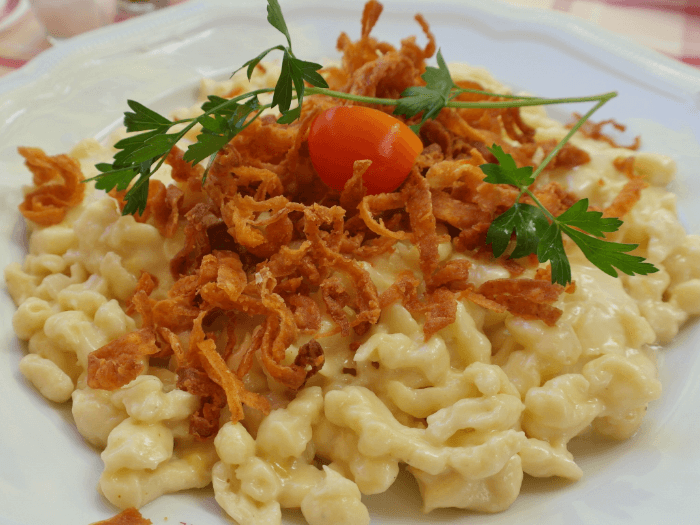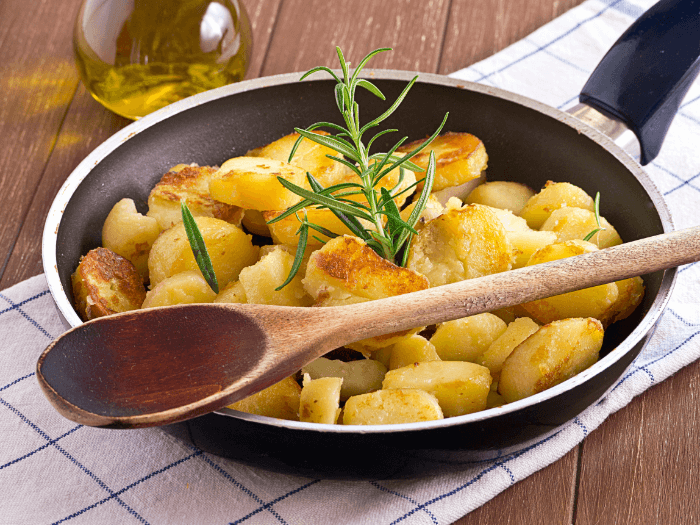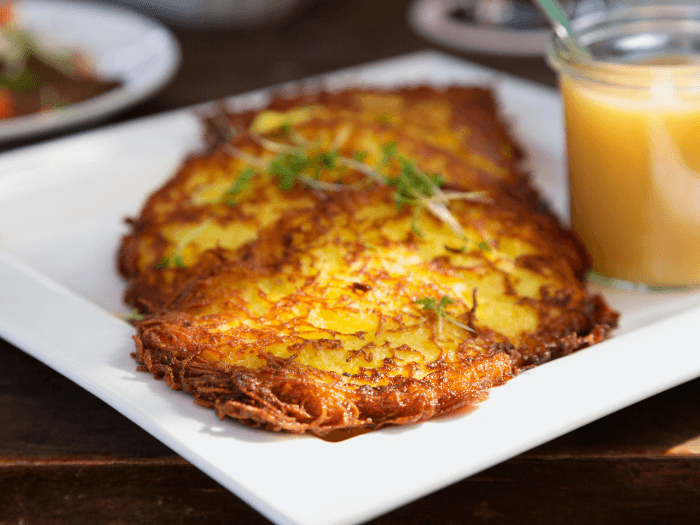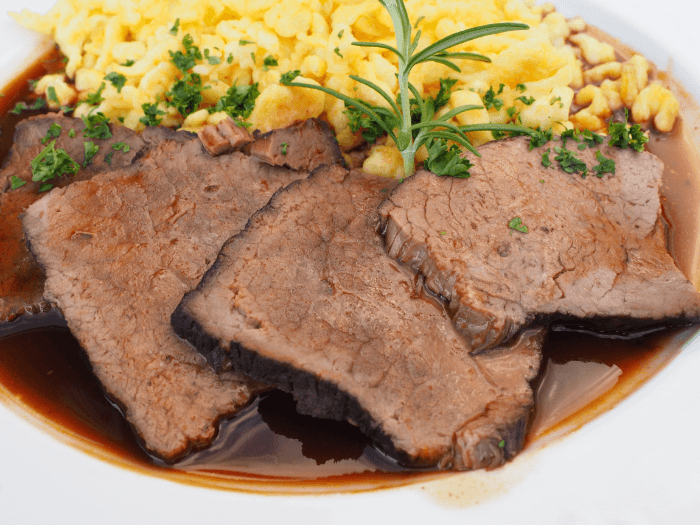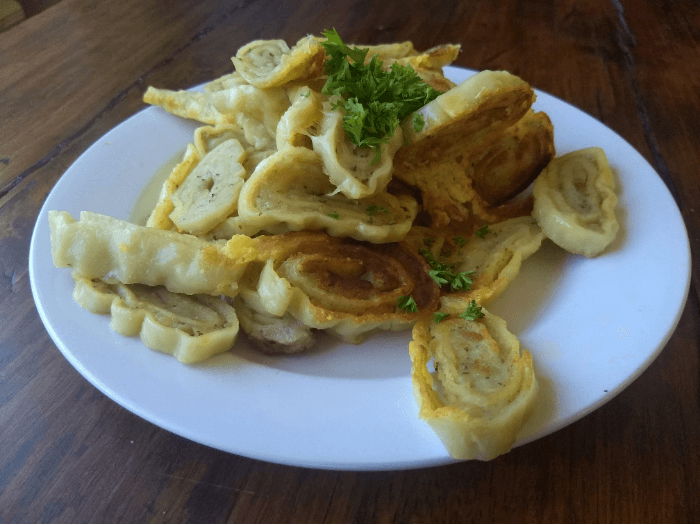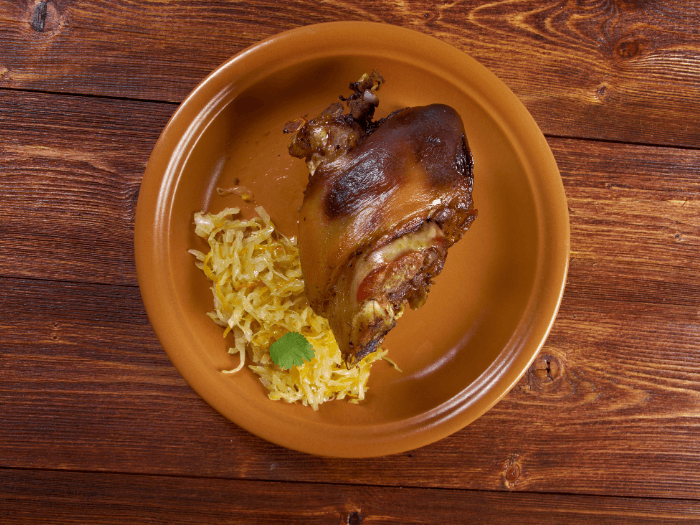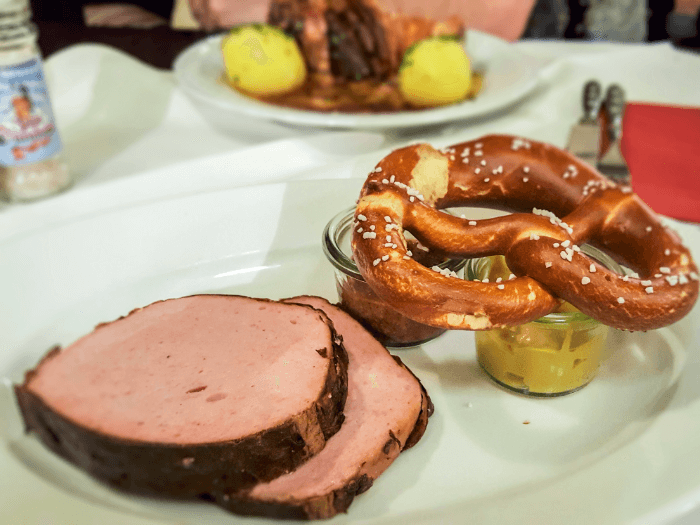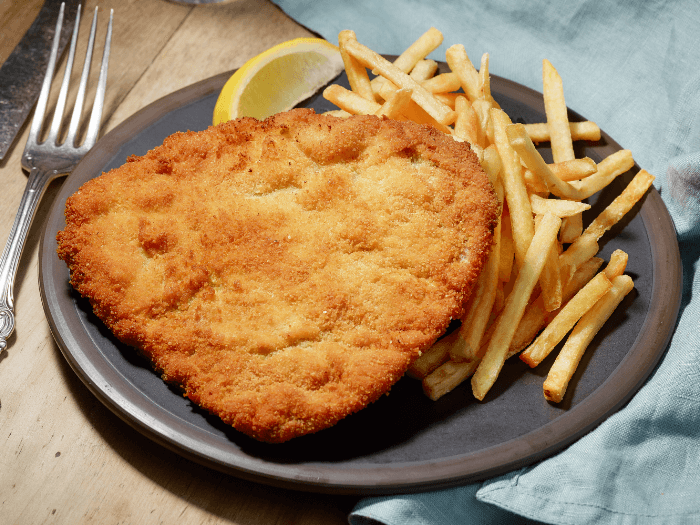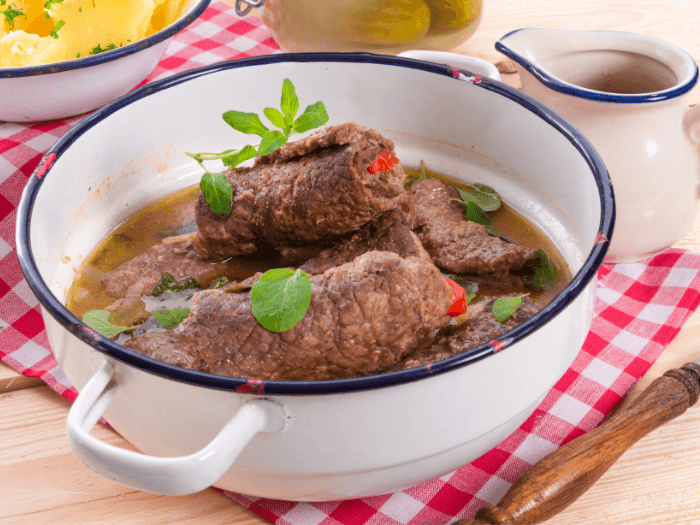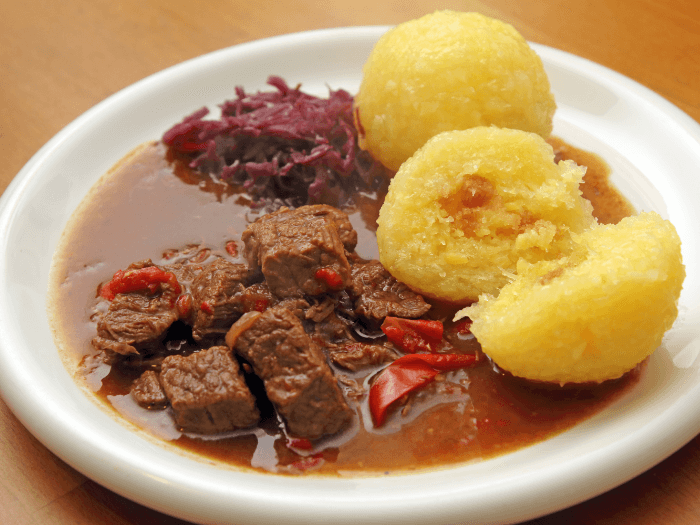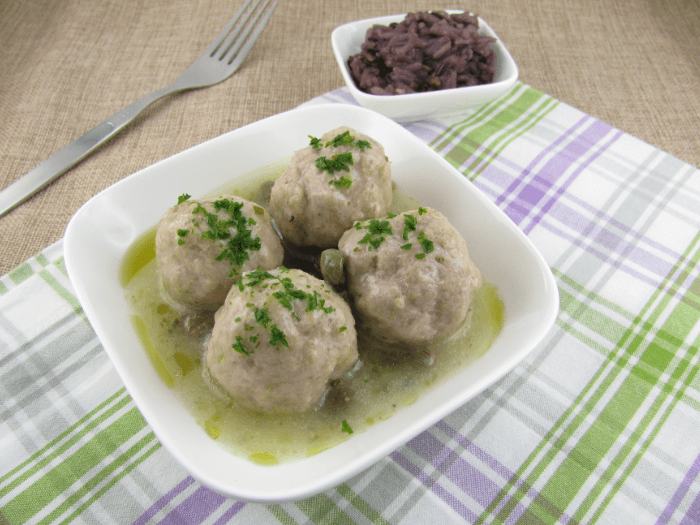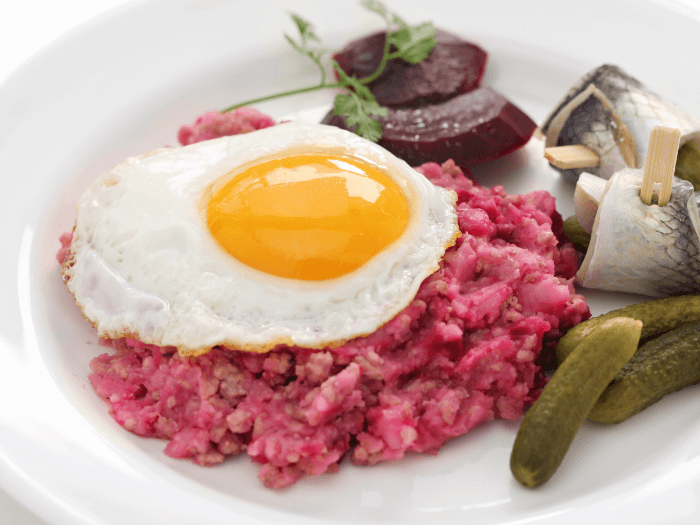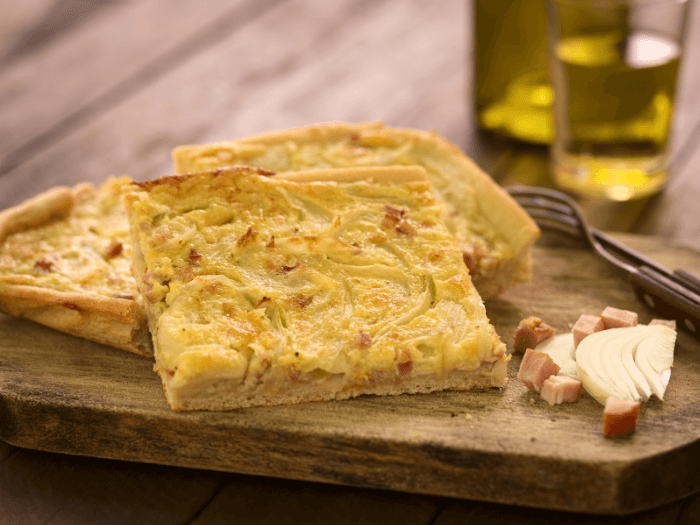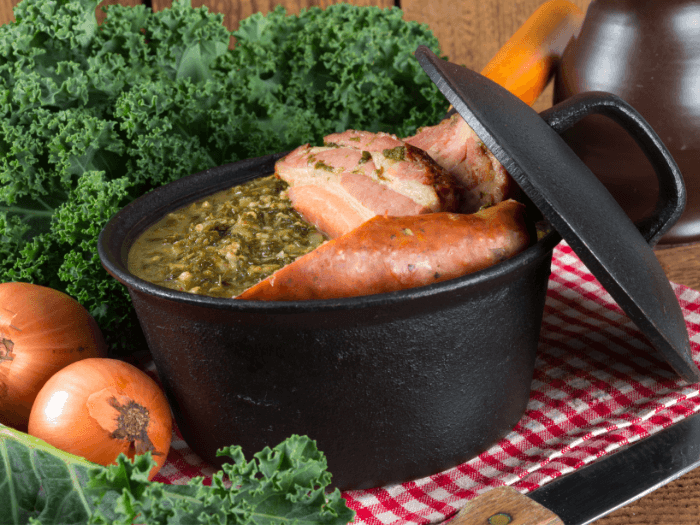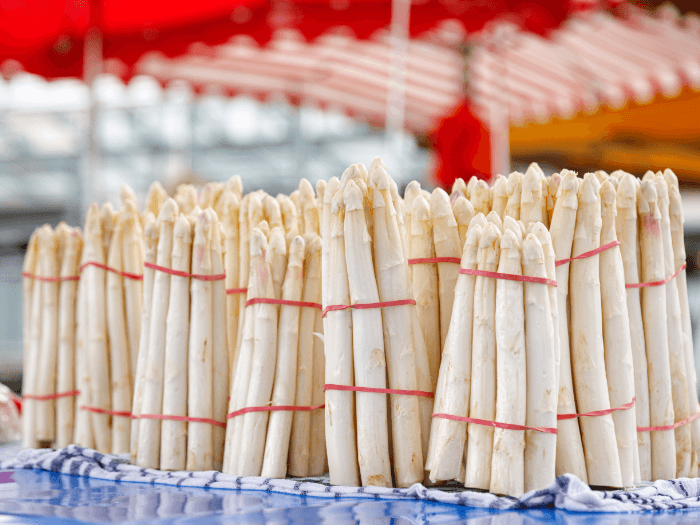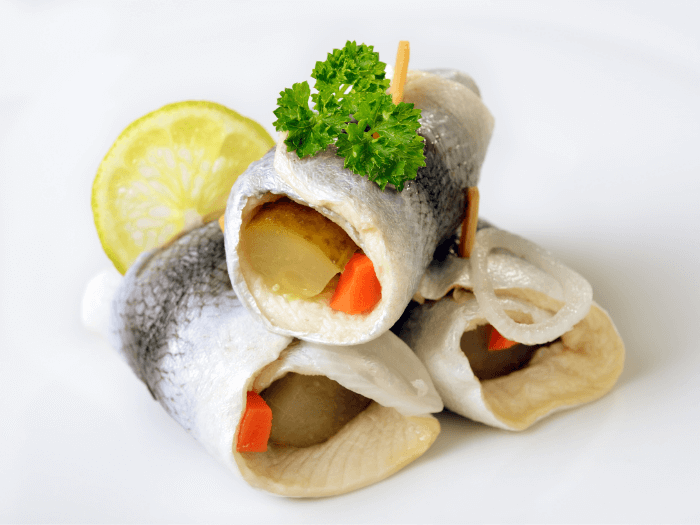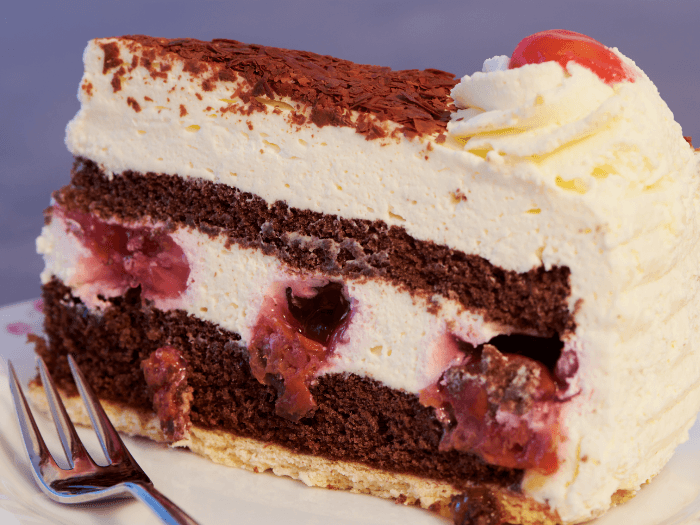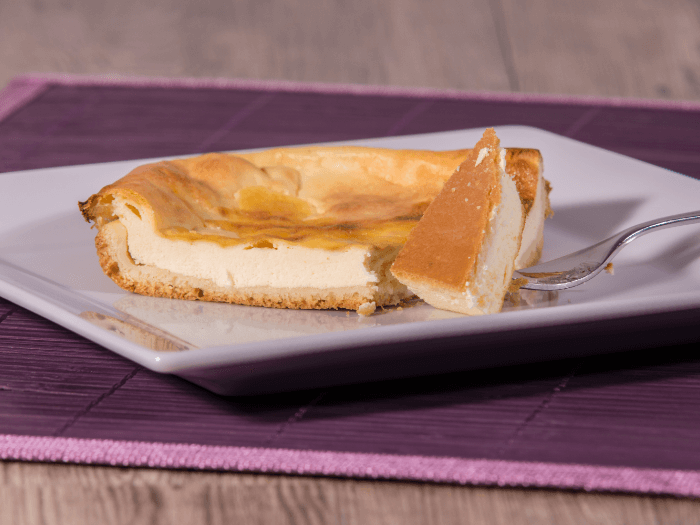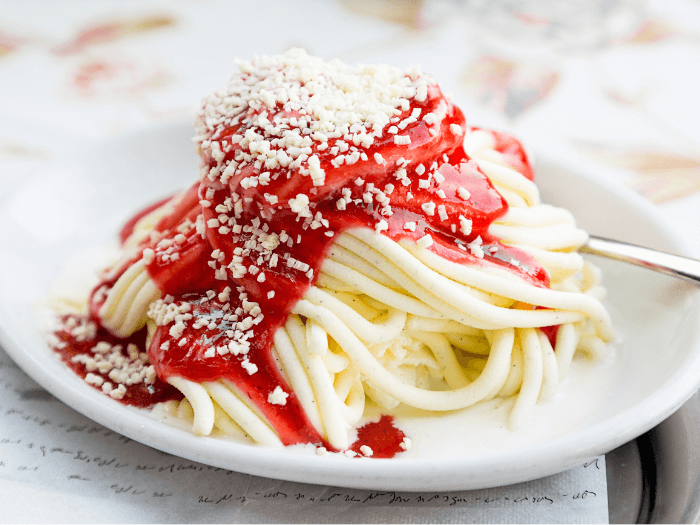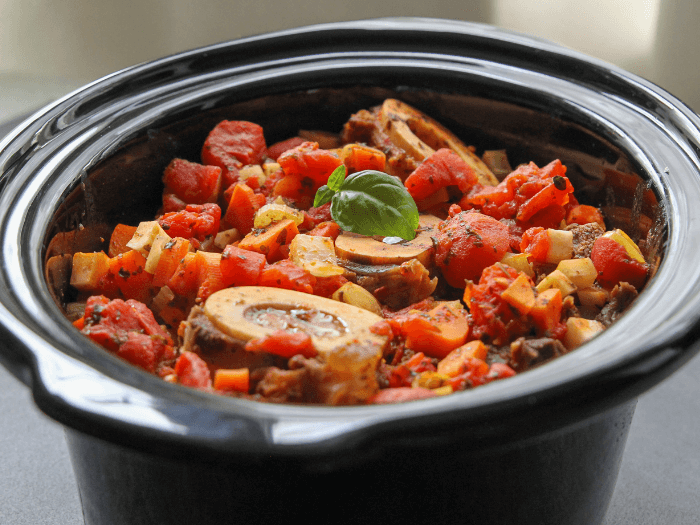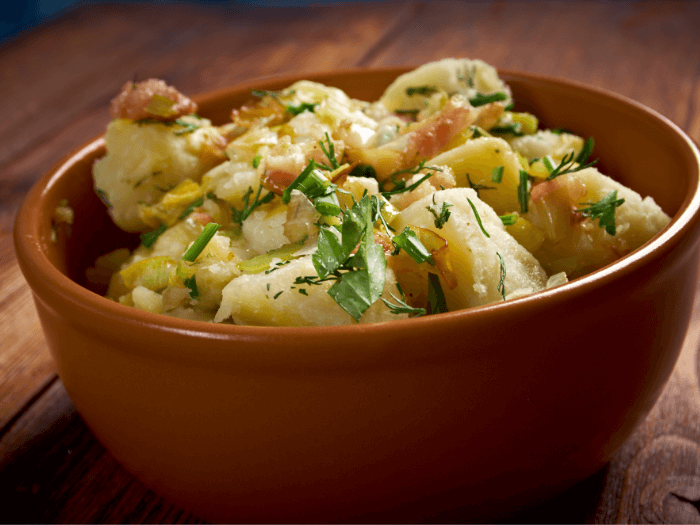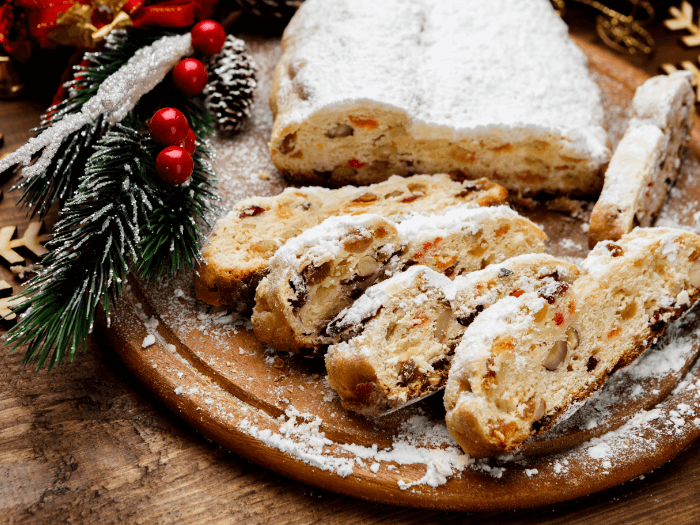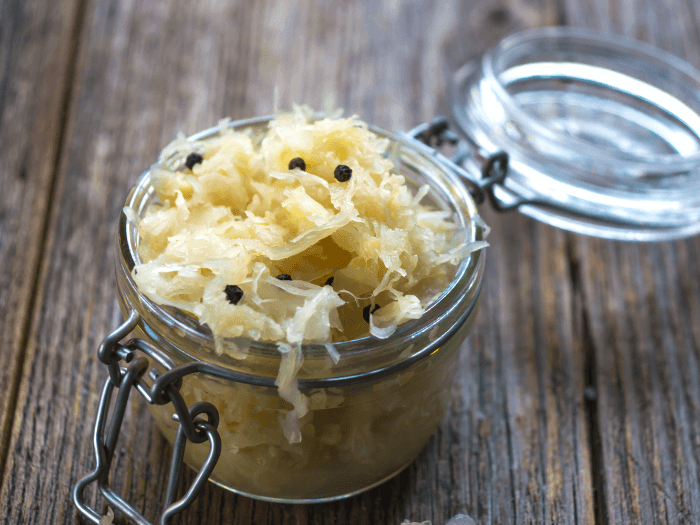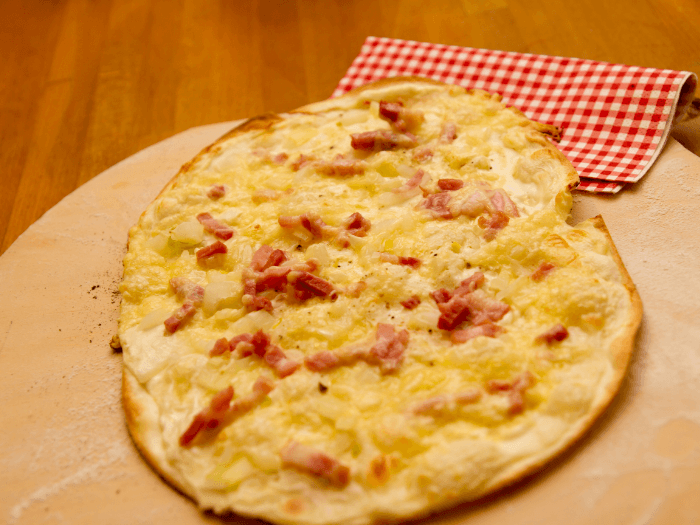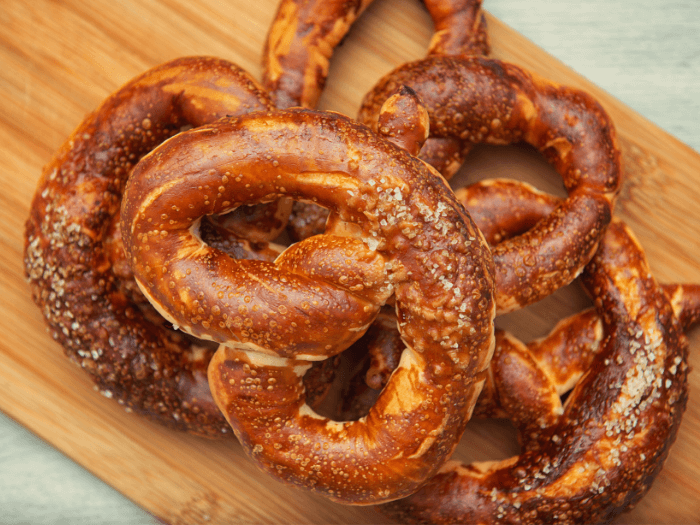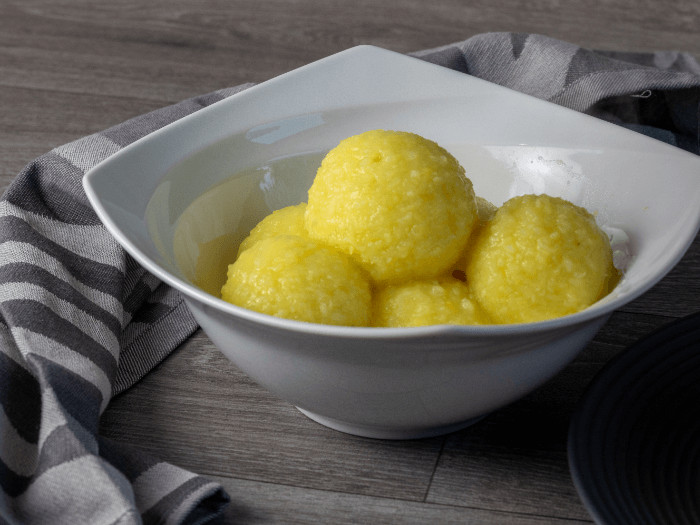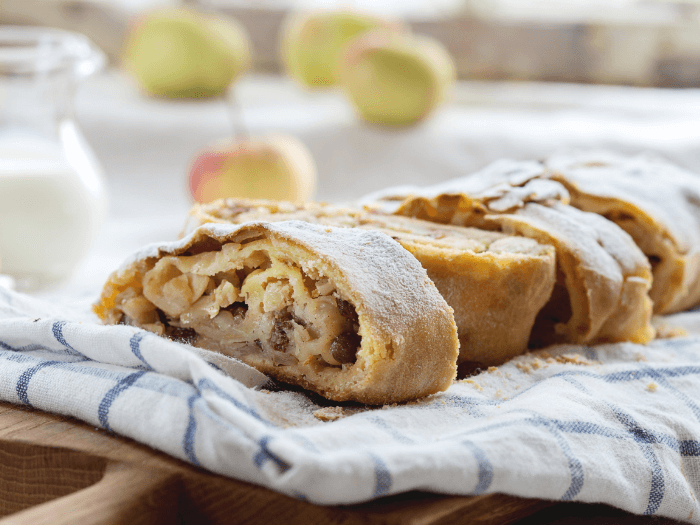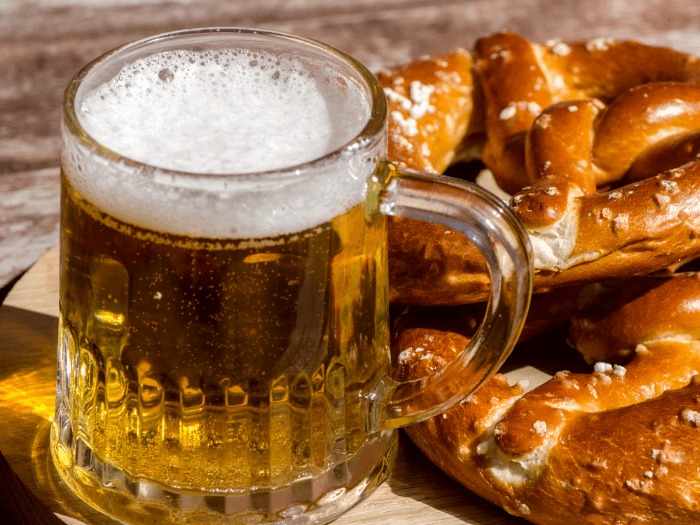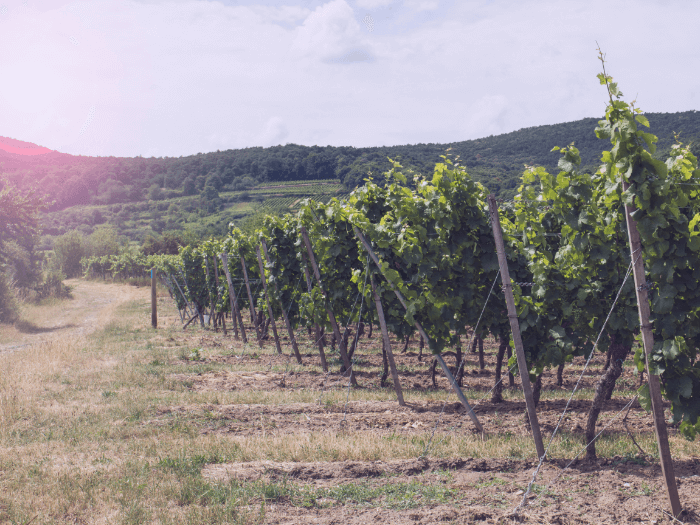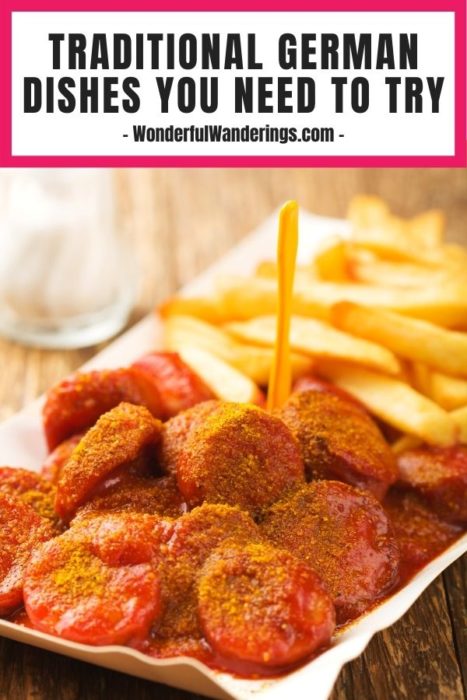Traditional German cuisine has left its mark all over the world, being a country with a rich culinary heritage. But Germany food is not just limited to sausages, sauerkraut, and potatoes – there are so many German dishes of all different types to try. German food is generally rich and full of flavor.
Not sure what foods to try in Germany? Here’s a list of foods to try while eating in Germany.
Contents
- What is Traditional German Food?
- Bratwurst
- Currywurst
- Saumagen
- Spätzle
- Bratkartoffeln
- Reibekuchen
- Sauerbraten
- Maultaschen
- Berliner eisbein
- Leberkäse
- Schnitzel
- Rouladen
- Gulasch
- Königsberger klopse
- Labskaus
- Himmel un ääd
- Zwiebelkuchen and federweisser
- Pinkel mit grünkohl
- Spargel
- Rollmops
- Schwarzwälder kirschtorte
- Käsekuchen
- Spaghettieis
- Eintopf
- Kartoffelsalat
- Dresdner stollen
- Sauerkraut
- Flammkuchen
- Hasenpfeffer
- Brezel
- Kartoffelkloesse
- Apfelstrudel
- German beer
- German wine
- Time to Enjoy Some Classic German Food
What is Traditional German Food?
Bratwurst
So, what do people in Germany eat? It will probably come as no surprise that the traditional food of Germany includes a lot of “wurst” (sausages) that come in many shapes, sizes, fillings, and flavors. In fact, there are over 1500 different types of sausage made in Germany.
The most popular food in Germany by far is the traditional bratwurst, of which there are over 40 varieties. This thin pork sausage is originally from Nürnberg and is considered one of the common foods in Germany, particularly at barbecues. Bratwurst is usually served with side dishes such as sauerkraut, potato salad, and fried potatoes or as street food with bread and mustard.
Elsewhere sausages are thicker and fattier, such as those from Frankfurt, or bloodier, such as the blutwurst (a bit like a black pudding) or the Bavarian bacon sausage called weisswurst.
Currywurst
Currywurst deserves a section all to itself because of the place it holds as one of the most famous German foods! This is a pork sausage served with a ketchup curry sauce, invented in 1949 by a Berlin woman called Herta Heuwer.
Heuwer produced the first example of this German famous food after she got hold of ketchup and curry powder from British soldiers. She sold them from a street food stall in the Charlottenburg district of Berlin to construction workers who were rebuilding the war-stricken city.
It could easily be considered Germany’s favorite food due to the museum dedicated to it in the capital city of Berlin. Apparently, 800 million are consumed every year.
Saumagen
If you’ve ever eaten Scottish haggis, you might have an idea of what to expect from Saumagen (which translates as “sow’s stomach” in English). This common German food is made with the stomach of a pig, stuffed with a mixture of pork, carrots, potatoes, onions, nutmeg, white pepper, and marjoram.
This is then sliced and either roasted in the oven or fried on the stove. It’s a popular German food in the Palatinate region and is usually served with sauerkraut.
Spätzle
Although this is not under any circumstances to be called pasta, spätzle is basically the equivalent. This German traditional food is made of egg noodles (created by combining flour, eggs, salt, and sometimes fizzy water to add fluffiness) and is usually served as a side for meat dishes.
Spätzle is also typical food in Germany for vegetarians as it’s often offered as the main meal in restaurants. There’s a cheesy variant called Käsespätzle which resembles American mac and cheese.
Bratkartoffeln
Also known as German Fries, Bratkartoffeln is one of the delicious traditional German side dishes made from fried sliced potatoes. Flavors, spices, and extras such as bacon and onions are often added to this German cuisine.
Reibekuchen
Every season is the season for reibekuchen in Germany. They are fried potato pancakes that have many different names and variations. You might see this traditional German dish on the menu as kartoffelpuffer, reibekuchen, reibeplätzchen, grumbeerpannekuche, reiberdatschi, and other names.
It’s an authentic street food favorite instead of a typical German breakfast like traditional pancakes. Although it is one of many popular dishes in Germany all year round, the German Christmas markets always offer fantastic potato pancakes, often served with sour cream and apple sauce. This traditional German dinner can also be prepared with treacle or black pumpernickel rye bread.
Sauerbraten
When asked what some common German dishes are, many locals would quickly suggest Sauerbraten. It’s considered by many as the national food of Germany. It was traditionally made with horsemeat, but nowadays, it’s mostly beef or venison.
This tender and soft meat specialty is created by slow-cooking beef that has been marinated in vinegar (which tenderizes it), herbs, and spices for several days. Once it’s ready, it quickly becomes one of the popular German foods in the area thanks to its aromas filling the air.
German meat dishes like Sauerbraten are usually served with potatoes of some sort or spätzle, along with some red cabbage and sauce. There are many different regional variations of Sauerbraten – whether the marinade uses wine or vinegar and other nuances.
Maultaschen
Now for one of the unusual famous foods in Germany. Maultaschen is a kind of ravioli pasta. There are many types of German dumplings. The egg-based dough can be stuffed with meat, spices, and sometimes vegetables.
The authentic German recipe is stuffed with minced meat (pork or beef), bacon, ham, onions, spinach, and breadcrumbs, with plenty of seasoning, herbs, and spices such as nutmeg, parsley, and marjoram. These large stuffed dumplings are then either boiled and served with a creamy sauce or pan-fried with butter. You can see why it’s one of the more popular German meals.
There is a legend in Germany that tells the tale of the monks of Maulbronn monastery using this German comfort food to sneakily disguise the fact they were eating meat when it was forbidden. Whether this is true or not, who knows, but in 2009 these delicious dumplings were noted as an important part of the German food culture of Baden-Württemberg.
Berliner eisbein
One of Berlin’s most popular German dishes, eisbein, is cured pork knuckle or ham hock, usually served up with sauerkraut and pea purée. The cured pork is simmered in a flavorful stock with juniper berries, onions, garlic, and the all-important German beer.
This is one of the most tender and succulent common German meals – the curing intensifies the flavors of the meat, while the slow cooking makes it fall off the bone. The name eisbein (“ice-bone”) refers to the bone that runs through the meat, which used to be used as the blade for ice skaters! In the south, one of the similar German dinner foods is called Schweinshaxe.
Leberkäse
Less of a meal in itself and more of traditional German lunch or daytime snack, leberkäse is a kind of meatloaf made from salted beef or pork and onions, which is minced and baked. This crusty meat block is then sliced and served with bread, pickled gherkins, or sometimes as a main dish with a potato salad or fried egg.
It’s one of the more traditional foods in Germany, as it was first invented in 1776 by a Bavarian butcher. Its name translates as “liver cheese” (which doesn’t sound like it would make the Best German Dish list!), and according to German food law, a minimum of 4% of the dish has to be made of liver. Today, leberkäse is popular in the South of Germany, where it is considered a delicacy.
Schnitzel
One of the most common German foods is schnitzel, which can be found in many different iterations not just in the country but throughout Europe. Schnitzel is a thin boneless cutlet of meat coated in breadcrumbs and fried.
One of the most popular German foods is the Wiener schnitzel, made with veal, but there is also (confusingly) the Schnitzel Wiener Art which is pork. You can also find schnitzel made from chicken breast and even soy or cheese.
The main dish in Germany is served with a good ladling of sauce, such as Jägerschnitzel (with mushroom sauce), rahmschnitzel (with cream sauce), or zigeunerschnitzel (with red pepper sauce). In Hamburg, the schnitzel is served with onions and fried eggs, while in Spreewald, it is spread with other traditional German foods such as horseradish, gherkins, and baked cheese.
Rouladen
As the name might suggest, this delicacy involves rolling! It’s fiddly food from Germany to prepare at home but a delicious one. Rouladen is created by making a filling of bacon, mustard, pickles, and onions and wrapping it up with a thin slice of beef or veal.
These stuffed rolls of meat have a really unique flavor. It’s one of the most popular German food items in the west and is best served with red cabbage and classic potato dumplings or mashed potato.
Gulasch
When do traditional German dishes become part of a country’s heritage? Gulasch (or goulash) originates from Hungary but has been absorbed into many nearby European nation’s cultures and menus. Residents eat gulasch as if it is part of a typical German diet. As one of the most popular foods in Germany, It’s a hearty and rich traditional meat stew that is the perfect comfort food on a wintry day.
The German dinner food version uses venison, pork, beef, or wild boar. It’s a spicy stew or soup served with potatoes, dumplings, rice, or noodles and found in restaurants and homesteads throughout the country.
Königsberger klopse
Ever wondered what is Germany’s national dish? One answer is the Königsberger klopse. It’s a traditional German national dish named after the former city of Königsberg, the once capital of East Prussia. Another meat dish with a twist – Königsberger klopse are meatballs in a creamy caper sauce.
The meatballs are molded from minced veal (although you can make a cheaper version with beef or pork) together with onions, eggs, spices, and breadcrumbs. The national dish of Germany also has anchovies. These meatballs are then simmered, and their broth is mixed with cream and egg yolk to create a silky sauce topped with capers. Served with boiled potatoes and beetroot, this makes a delicious typical German dinner.
Labskaus
Considered one of the most popular authentic German dishes in the north, Labskaus is a strange-looking dish created from potatoes and meat – and, all importantly, beetroot (which gives it a fantastic color!). These ingredients are mashed together, creating a pink dollop of Labskaus, garnished with pickled cucumbers and rollmops to make one of the more unique German specialty foods.
This colorful specialty was apparently German staple foods for the Baltic and North Sea seafaring folk – an easy meal for sailors and fishermen on the great ships.
Himmel un ääd
Some iconic German food names are really great – such as himmel un ääd, which translates as “heaven and earth.” It’s authentic German food that has been around since the 18th century and is prepared with black pudding, mashed potatoes, and fried onions with a delicious apple sauce.
Supposedly, the German name is in reference to the ingredients and the two different types of apples. The apples from the trees (the sky) and the apples from the earth (the potatoes). This dish is popular in the Rhineland, Westphalia, and Lower Saxony regions of Germany.
Zwiebelkuchen and federweisser
The best way to describe “zwiebelkuchen” is that it is a bit like a quiche. It’s one of the more traditional German egg dishes featuring an onion tart made with rich cream, fluffy eggs, fried onions, and bacon bits. It is often paired (and with good reason) with “federweisser” – a fermented sweet, freshly pressed grape juice that literally translates as “featherlight.”
It’s one of the unique German foods that is perfect on hot summer days and widely found throughout the villages, towns, and cities on the river Mosel.
Pinkel mit grünkohl
Pinkel is one of the favorite German foods in the north. It’s also enshrouded in mystery – because the local butchers guard the secret of how to make it! It’s thought that its name comes from the German word “pinkelt,” meaning little finger.
The sausage includes ingredients such as oats, bacon, beef suet, onions, pig lard, and seasoning. It’s traditionally served up with kale – “pinkel mit grünkohl” – and, of course, some sort of potato side.
Spargel
Spargel is a white asparagus that is hugely popular throughout the country and served in restaurants in many different forms. However, it’s only available for a few months a year. The season for “spargel” in Germany is called “spargelzeit” and runs from mid-April to the end of June (the official end of spargelzeit is the 24th of June, which is St John the Baptist Day).
These tender and sweet vegetables are served traditionally with butter and potatoes, but sometimes they are presented with hollandaise sauce or scrambled egg. Like elsewhere in Europe, these revered nutritious stalks are known colloquially as “white gold.”
Rollmops
Rollmops are often seen as a garnish or snack, as opposed to one of the typical German foods. But they are often served as a side dish for German main dishes or even a breakfast in themself. Pickled herring is wrapped around a savory filling of pickled gherkins or olives. Believe it or not, typical German meals like this are a hangover breakfast cure!
Schwarzwälder kirschtorte
One of the country’s finest dessert exports is also a famous German food, “Schwarzwälder kirschtorte” – also known as the Black Forest gateau. This rich cake is a sandwich of chocolate sponge, whipped cream, and sour cherries adorned with whipped cream, chocolate shavings, and maraschino cherries.
This famous traditional German cake was invented in 1915 by Josef Keller in Bonn in Rhineland. Some say it gets its name from the colors of the traditional costumes of the people who live in the Black Forest (white, brown, and red), but most think it’s named after the regional cherry liquor – Schwarzwälder kirsch.
Käsekuchen
German cheesecake (Käsekuchen) is a light and fluffy version of its western counterpart. This is because it’s made with quark or Greek yogurt instead of cream cheese. Egg white is added to fluff up the filling, often together with a dash of lemon for freshness.
Unlike the cheesecakes of other countries, Käsekuchen is not normally made with a feature fruit – but of course, there are regional varieties throughout Germany.
Spaghettieis
Do you know what German food was invented by an Italian? It’s Spaghettieis, a popular sweet specialty in Germany. Rather unusually, this is vanilla ice cream molded to look like spaghetti and topped with a bright red strawberry sauce intended to look like tomato sauce. It is then decorated with white chocolate shavings to resemble parmesan cheese.
The end result is a surprisingly realistic impression of spaghetti bolognese, especially popular with German children. It was invented by the son of an Italian immigrant, Dario Fontanella, in Mannheim, Germany. He says he had fun tricking children into believing it was a plate of spaghetti!
Eintopf
Translating literally as “one-pot,” Eintopf is a very simple affair created by pretty much anything and everything you have to hand. This traditional German meal is a stew-like soup formed of vegetables and some sort of meat. Anything goes here!
Kartoffelsalat
Kartoffelsalat is Germany’s famous potato salad. The foods of Germany are widely credited with the invention of this now-popular European delicacy, usually made from boiled potatoes together with mayonnaise, mustard, and lemon juice dressing.
There are a myriad of different versions of this side dish served all over Germany and the wider world. Some contain meat such as bacon or ham, while some add scallions, chives, or other fresh herbs. Sometimes you might find a hard-boiled egg sliced up in the salad or green beans.
Dresdner stollen
Stollen is one of the most popular German Christmas dishes. It’s a delicious and filling sweet bread. The dessert has roots in the 15th century and has been a famous food in Germany at Christmas markets ever since. It used to be called “striezel,” and this is why the Christmas market in Dresden is called Striezelmarkt today.
So what is Dresdner stollen actually made from? It’s a heavy bread baked with nuts, raisins, spices, candied fruits, and marzipan, dusted with a finish of icing sugar. It’s an important typical German meal when the weather turns cold!
Sauerkraut
Believed to have endless health benefits, sauerkraut is one of the most popular German traditional dishes. It’s created from fermented cabbage, a process carried out by picking shredded cabbage leaves. The lactic acid bacteria created by the fermentation gives it a really distinctive sour taste.
Although it’s now one of the most famous German dishes, the history of the fermentation of vegetables is much older. Some believe that it was brought to Europe by the Mongol emperor Ghengis Khan.
Flammkuchen
Flammkuchen is a kind of German pizza using a covering of white cheese or creme fraiche rather than the Italian tomato base and a smattering of fried onions and bacon lardons.
Flammkuchen has an interesting history. It was originally the “flame-cake” that was traditionally used to test the temperatures of bread ovens in the German-France border regions of Alsace, Baden, and the Palatinate. If the oven were up to the correct temperature, the cake would bake in one or two minutes and be crusty and crispy.
Hasenpfeffer
Hare or rabbit is considered quite a common German national food and the main ingredient in Hasenpfeffer – hare stew. It’s a delicious tender stew of rabbit or hare in a flavorful marinade, cooked with a multitude of herbs and spices such as sage, thyme, bay leaf, and juniper berries.
As with most traditional food in Germany, the meat is made tender by a lengthy cooking process. The marinade is often thickened with the rabbit’s blood. Truly one of the German delicacies you need to try!
Brezel
One of the most celebrated German street foods is the famous pretzel. A decorative traditional German bread twisted into a knotted shape and sprinkled with salt, the pretzel <“brezel”) is a delicious snack or accompaniment to a “bratwurst” and is one of the typical foods in Germany.
Kartoffelkloesse
You might have gathered by now that potatoes are paired with many classic German dishes. So here is another variation on the humble potato – potato dumplings!
Kartoffelkloesse is potato dumplings normally served as a side for meat dishes, formed from mashed potatoes that have been remolded into balls before being boiled.
Not exactly a German delicacy, but true comfort food and pretty filling. It’s a German typical food, and you’ll find it in many traditional restaurants.
Apfelstrudel
The apple-based dessert, Apfelstrudel, is perhaps the most famous food in Germany and is eaten and cherished worldwide. Although it originates in Austria (dating back to 1696), it deserves mention here as it has been a part of German food traditions for a long time and is served throughout the country today.
“Strudel” is, in fact, a German word meaning whirlpool – like the swirling shape created by the pastry and filling. Apfelstrudel is made with grated cooking apples, flavored with cinnamon, sugar, and raisins, and wrapped in a buttery pastry jacket. The pastry is flakey and paper-thin, and the strudel is served in slices sprinkled with icing sugar.
German beer
Along with Germany’s food, the country is well known for its beer culture. The most popular German beer is a pilsner, a pale lager brewed in different variations in most towns.
Bavaria is a famous region for beer in Germany because of the abundance of hops of different varieties that grow there. This is where you’ll find hefeweizen or other wheat beers, which are among the most popular German beers, along with the pale light lagers. Beer drinking in Germany is a huge traditional export that goes back centuries.
German wine
Germany might mainly be known for its white wine (the Riesling grape variety being the most famous), but it is increasingly producing some excellent red wine, such as the German Pinot noir called Spätburgunder.
Most vineyards are found in the west of Germany, near the river Rhine, and Germany is currently the world’s eighth-largest wine-making country. Its exports are primarily white wine, with only a third of all German wines being red wine.
Time to Enjoy Some Classic German Food
Now you know the answer to what do people eat in Germany. You also have a round-up of some of the yummiest typical German food. No matter what flavor you desire, there are many types of German food that will tantalize your tastebuds. The only advice left to give you is… don’t try all these meals in Germany at once!
PIN FOR LATER

